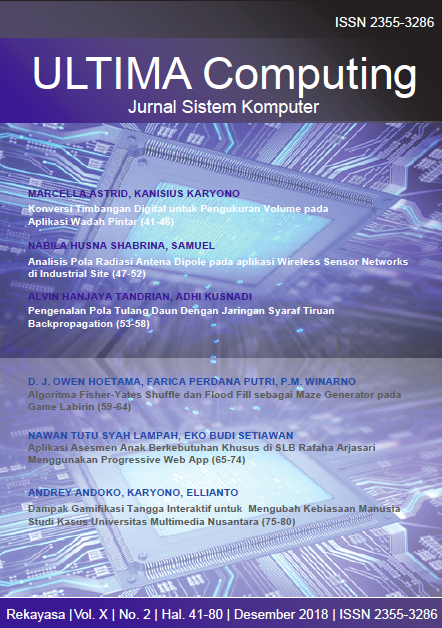Analisis Pola Radiasi Antena Dipole pada aplikasi Wireless Sensor Networks di Industrial Site
DOI:
https://doi.org/10.31937/sk.v10i2.929Abstract
In industry 4.0, a complex system was needed to automatically control and communicate between devices. One component that often used in industrial automation is Wireless Sensor Networks (WSN), which is worked by transmitting the data needed through electromagnetic waves. The electromagnetic propagation in industrial process encounter challenges which caused by reflection or scattering from the object inside the industrial site. Therefore, in this research, the author will conduct a simulation to determine the characteristic of electromagnetic propagation in industrial site. The simulation was done by simulating antenna dipole with frequency 2.4 GHz in the simple 3D industrial site consist of some component. The result shows that simulating antena dipole in industrial site will affect the characteristic of the antena such as gain, directivity, and S parameter.
Downloads
Downloads
Published
How to Cite
Issue
Section
License
Authors retain copyright and grant the journal right of first publication with the work simultaneously licensed under a Creative Commons Attribution-ShareAlike International License (CC-BY-SA 4.0) that allows others to share the work with an acknowledgment of the work's authorship and initial publication in this journal.
Authors are able to enter into separate, additional contractual arrangements for the non-exclusive distribution of the journal's published version of the work (e.g., post it to an institutional repository or publish it in a book), with an acknowledgment of its initial publication in this journal.
Copyright without Restrictions
The journal allows the author(s) to hold the copyright without restrictions and will retain publishing rights without restrictions.
The submitted papers are assumed to contain no proprietary material unprotected by patent or patent application; responsibility for technical content and for protection of proprietary material rests solely with the author(s) and their organizations and is not the responsibility of the ULTIMA Computing or its Editorial Staff. The main (first/corresponding) author is responsible for ensuring that the article has been seen and approved by all the other authors. It is the responsibility of the author to obtain all necessary copyright release permissions for the use of any copyrighted materials in the manuscript prior to the submission.















